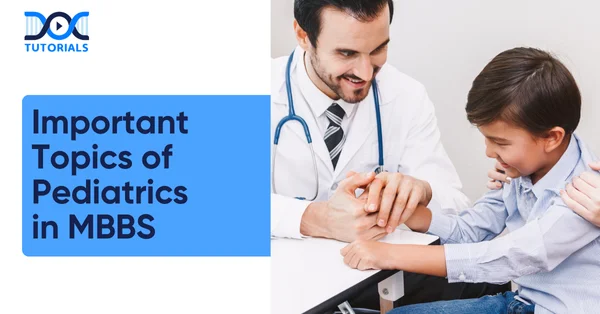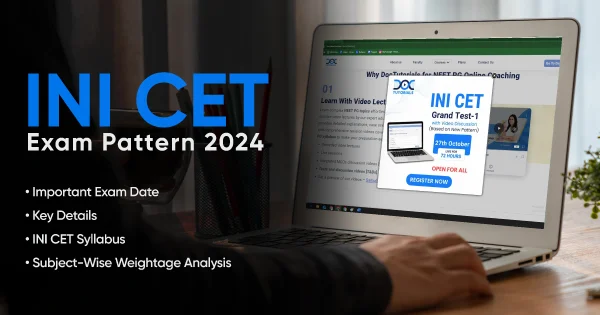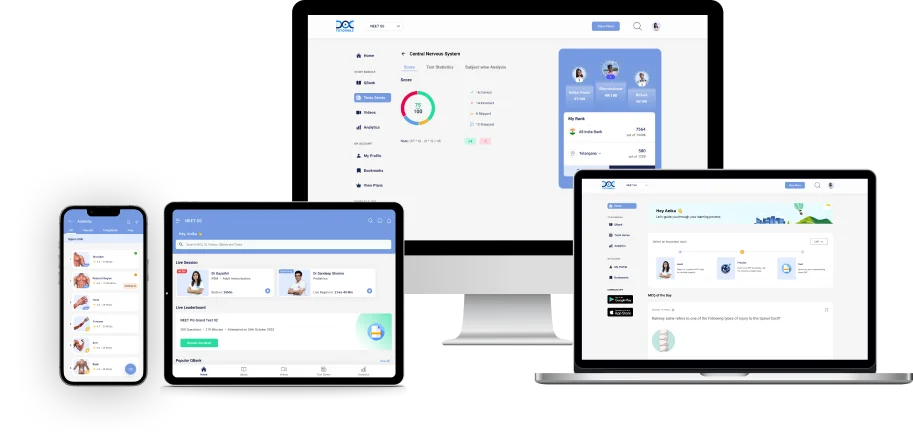Important Topics of Pediatrics in MBBS

With only 11 months remaining until NEET PG 2026, medical aspirants are in preparation mode. There is a smarter way to make your study time count by mastering the Paediatrics syllabus. It is equally crucial to retain what you’ve learned and recall it during the exam.
That’s where focused and well-planned preparation makes all the difference. Instead of trying to revise every single detail, shift your focus towards the high-yield topics, the ones that truly matter and are most likely to appear in the exam.
In this article, we’ve compiled a list of essential paediatrics topics that will help streamline your preparation and boost your performance in NEET PG 2026. Keep reading to know further!
What are the Important Topics of Paediatrics in MBBS?
High-yielding topics for paediatrics in MBBS are:
1. Growth and Development
- Growth Evaluation: Key anthropometric indicators with the use of growth charts and standard references.
- Anthropometric Measurements:
- Weight: Guidelines for accurate infant weighing, average weight gain by age group, and expected weight standards.
- Height/Length: Precautions during stadiometer measurement, normal values and annual rate of increase, upper segment–lower segment ratio, arm span.
- Head Circumference (OFC): Measurement steps and brain growth patterns.
- Abnormal Growth Patterns:
- Short Stature: Definition and physiological variants, mid-parental height (MPH) calculation, prenatal and postnatal causes, and disproportionate short stature causes.
- Tall Stature: Definition and Major Etiologies.
2. Head and Dentition
- Head Size and Shape Abnormalities:
- Microcephaly: Definition, classification, and causes (primary/secondary)
- Macrocephaly: Definition and common causes
- Abnormal Head Shapes: Variations and Clinical Types
- Fontanelles: Assessment of the anterior fontanelle
- Dentition
- Normal Eruption: Sequence of primary (milk) teeth and sequence of permanent teeth
- Abnormal Dentition: Delayed eruption, natal teeth, Hutchinson’s teeth
3. Developmental Milestones
- Overview and Principles of Development: Sequential and cephalocaudal progression
- Motor Development:
- Gross Motor: In ventral suspension and prone position, key milestones up to 5 years.
- Fine Motor: Hand-eye coordination and grasp development.
- Other Developmental Domains: Social development milestones, language milestones, and vision and hearing milestones.
- Developmental Implications: Importance of each domain (gross, fine, social, language).
4. Developmental Disorders
- Red Flags for Developmental Delay
- Major Causes
- Developmental Evaluation: Developmental Quotient (DQ) and Intelligence Quotient (IQ).
- Behavioural Disorders: Nocturnal enuresis, pica, thumb sucking, bruxism, breath-holding spells.
5. Puberty and Adolescence
- Pubertal Assessment: Sequence of pubertal changes in girls and boys, and Tanner staging and orchidometer use.
- Key Facts: Normal age variations, hormonal influence, and psychosocial aspects.
6. Neonatology
- Neonate Classification: Term, preterm, post-term, low-for-date neonates, features and complications
- High-Risk Infants: Common risk factors and management
- Primitive Reflexes: Reflexes at birth and appearing later (Rooting, Moro, ATNR/STNR, Parachute).
- Common Benign Neonatal Conditions: Skin and mucosal findings.
7. Neonatal Emergencies and Disorders
- Neonatal Resuscitation: NRP protocol: assessment, suctioning, ventilation, intubation, chest compressions, adrenaline, meconium management
- IUGR & Preterm Feeding: Symmetrical vs asymmetrical IUGR, causes, and prevention
- Neonatal Sepsis: Definition, classification, clinical features, management
- Thermal Regulation: Hypothermia (classification, prevention, KMC) and hyperthermia management
- Neonatal Hypoglycemia: Definition, treatment, and persistent cases
- Infant of Diabetic Mother: Common neonatal problems
- Perinatal Asphyxia: Definition, pathophysiology, diagnosis, HIE staging, management
- Neonatal Scoring Systems: APGAR, Silverman, Downe’s, CRIB, SNAP
8. Major Neonatal Conditions
- Respiratory Disorders: RDS (surfactant role, pathophysiology, diagnosis, prevention), pulmonary alveolar proteinosis, meconium aspiration syndrome, and TTNB (risk factors, management)
- NEC (Necrotising Enterocolitis): Bell’s staging and prognosis
- Jaundice: Physiological vs pathological, breastfeeding and breast milk jaundice, causes, and treatment.
- Erythroblastosis Fetalis: RH incompatibility, hydrops fetalis, investigations
- Recent Advances: Fetal growth restriction, antenatal steroids, CPAP, surfactant therapy, caffeine use, neonatal seizures, HIV management, and cord blood banking.
9. Nutrition and Metabolism
- Breastfeeding: Exclusive breastfeeding, influencing factors, expressed milk storage, contraindications, composition and anti-infective benefits
- Micronutrients: Vitamins (A–K) and iron roles, National Vitamin A Prophylaxis Programme
- Malnutrition: Anthropometric indices and classifications (IAP, Gomez, WHO, Wellcome), SAM management and POSHAN Abhiyan
- Body Composition & Acid–Base Balance: Total body water, ECF/ICF, osmolality, acidosis/alkalosis
- Electrolyte Disorders: Hyponatremia/hypernatremia, SIADH, hypokalemia/hyperkalemia, ECG findings.
10. Pediatric Immunology and Infections
- Immunodeficiency Disorders: Primary immunodeficiencies: XLA, CVID, SCID, etc.
- Pediatric Vasculitic Disorders: HSP, Kawasaki, juvenile dermatomyositis
- Major Viral Infections: Measles, rubella, chickenpox, HFMD, roseola, mumps, polio, HIV, MIS-C
- Bacterial Infections: Tuberculosis, diphtheria, pertussis, tetanus, scarlet fever
- Congenital Infections: TORCH, syphilis, prevention and treatment
- Immunisation: Concepts, schedules, IAP updates, vaccine handling (VVM, shake test, AEFI), individual vaccines like BCG, DPT, Hepatitis, Polio, HPV, etc.
11. Pediatric Systemic Disorders
- Cardiology: Fetal vs adult circulation, CHD classification: acyanotic (VSD, ASD, PDA) & cyanotic (TOF), and rheumatic fever and Jones criteria
- Haematology: Normal RBC physiology, anaemias: iron deficiency, thalassemia, sickle cell, aplastic anaemia, and bleeding and coagulation disorders (ITP, NAIT, leukaemias, lymphomas)
- Pediatric Tumours: Retinoblastoma, neuroblastoma, Wilms’, CNS tumours
12. Pediatric Organ Systems
- Gastrointestinal Disorders: GERD, EA/TEF, pyloric stenosis, diarrhoea, celiac, Hirschsprung’s
- Liver Disorders: Hyperbilirubinemia, hepatitis, Wilson’s, Reye’s
- Respiratory Disorders: Congenital defects, asthma, pneumonia, cystic fibrosis
- Nephrology: CKD, nephrotic and nephritic syndromes
- Neurology: CNS malformations, seizures, brain death
How to Prepare for Paediatrics in MBBS?
Following these steps to master key paediatric concepts can significantly enhance your NEET PG preparation and clinical confidence. Here are a few strategies to help you out:
- Classify the Causes: Organising causes for different conditions helps you memorise information more effectively and recall it easily during exams. Structuring causes systematically allows for quicker understanding and better long-term retention.
- Age as a Vital Factor in Anthropometry: Age plays a crucial role in anthropometric assessments. Clinically, it aids in diagnosing malnutrition and monitoring child growth across populations, ensuring accurate interpretation of developmental milestones.
- Understand Micronutrients and Electrolytes Thoroughly: A deep understanding of micronutrients and electrolytes is essential, as even minor imbalances can significantly affect the body’s major systems. Paying attention to these small yet impactful details can make a real difference in clinical decision-making.
- Focus on High-Yield Topics: Conditions such as diarrhoea, bronchiolitis caused by the respiratory syncytial virus (RSV), nephrotic syndrome, and haemolytic uraemic syndrome (HUS) are among the most critical topics to study. Prioritising these will strengthen your core paediatric knowledge.
- Develop Differential Diagnosis Skills: Differential diagnosis tests your clinical reasoning. Utilise symptom-based and problem-based approaches to think critically, interpret findings, and draw accurate conclusions. This analytical skill is fundamental for both exams and real-world practice.
- Know the Management and Investigations: In paediatrics, understanding management involves more than treatment; it requires mastering diagnostic investigations. These investigations form the backbone of accurate diagnosis and effective patient care.
- Newborn Examination: Give special attention to neonatal and postural reflexes, noting when they appear and disappear. This understanding helps assess neurological development and detect potential abnormalities early on.
- The Ballard Score: Be clear about the Ballard Score, which evaluates a newborn’s physical and neuromuscular maturity. It’s particularly useful within the first four days after birth and is a vital tool in neonatal assessment.
FAQs about Important Topics in Paediatrics in MBBS
- What are the most important topics in Paediatrics for MBBS students?
Key topics include growth and development, nutrition, immunisation, infectious diseases, neonatal care, and common disorders like diarrhoea, bronchiolitis, and nephrotic syndrome. Understanding these builds a strong foundation for both clinical practice and NEET PG preparation.
- Why is growth and development important in Paediatrics?
Growth and development assessment helps detect malnutrition, developmental delays, and endocrine or genetic disorders early. Tracking milestones and anthropometric parameters allows timely intervention, ensuring better health outcomes and proper monitoring of a child’s physical and cognitive progress.
- How should MBBS students study Paediatrics effectively?
Start with NCERT-based basics, focus on high-yield clinical conditions, and revise through flowcharts, tables, and mnemonics. Case-based learning and solving previous year NEET PG questions help strengthen clinical reasoning and improve exam readiness.
- Why are micronutrients and electrolytes crucial in Paediatrics?
Even slight imbalances in micronutrients or electrolytes can disrupt vital systems, affecting growth, metabolism, and immunity. A solid grasp of their physiological roles and deficiency symptoms is essential for accurate diagnosis and effective paediatric management.
- What makes newborn examination an essential topic?
Newborn examination helps assess reflexes, physical maturity, and congenital abnormalities. Understanding neonatal reflexes, the Ballard score, and early signs of distress ensures prompt detection and management of complications in the critical first days of life.
Conclusion
Mastering the important topics in Paediatrics not only strengthens your MBBS foundation but also gives you a clear edge in NEET PG preparation. With focused study on growth, development, nutrition, neonatal care, and common paediatric disorders, you build both knowledge and clinical confidence.
For extra guidance, DocTutorials can be your study partner. We offer animated lectures, exam-oriented preparation, a dedicated Qbank, university-specific PYQs, and structured mentorship with complimentary hardcopy notes in our MBBS curriculum.
Join DocTutorials today and explore our MBBS course to excel in your medical career!
Latest Blogs
-

INI CET Exam Pattern 2025: A Complete Guide with Subject-Wise Weightage
The Institute of National Importance Combined Entrance Test (INI CET) is your key to entering some of the most prestigious…
-

NEET PG Registration 2025: An Essential Guide For Exam Prep
The NEET PG registration, which is conducted online, is a crucial step in the exam process. Filling out the NEET…
-

NEET PG Syllabus 2026: A Must-Have Complete Guide for Exam Success
The NEET PG Syllabus acts as one of the foundation stones for aspiring postgraduate medical students like you who are…




